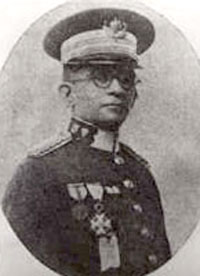9.13 Luis Casas Romero. Composer, flautist, and founder of Cuban Radio.

Luis Casas Romero was a Cuban composer and flautist; born on May 24, 1882, in Camagüey. He distinguished himself in the history of Cuban music for his contribution to the founding of the era of radio programming on the island. At the age of 9, he began his musical studies with the Spanish maestro Gregorio Cánova Macaró; and in 1893, he joined the Santa Cecilia Popular Society orchestra.
He always professed a great love for his country and resisted Spanish colonialism, so at the age of 15 he joined the Liberation Army, under the command of General López Recio.
In 1901, he founded and directed the Camagüey Children’s Band. That same year, he moved to Havana, where he became a flutist and orchestra conductor at the Martí Theater.
Luis Casas Romero performed in the Mexican cities of Mérida and Veracruz as conductor of the Raúl del Monte Company; he settled permanently in Havana in 1907 and worked as a flutist in the Alhambra Theater orchestra, supervised by Jorge Anckermann.
The following year, he conducted the Neptuno Orchestra and joined the sextet that performed at the Martí Theater. He also served as orchestra director at the Payret Theater (Paseo de Martí No. 513, Old Havana, Havana), the Alhambra Theater, the Molino Rojo Theater, and the Zarzuela Company. He also taught flute, music theory, harmony, composition, and band and orchestral instruments at the Hubert de Blanck Conservatory, beginning in 1909.
He joined the Columbia Camp General Staff Band as a flutist in 1913. Five years later, he served as its assistant director and was appointed its director until his death. In 1918, he founded the first electromechanical piano roll factory, with the collaboration of figures such as Ernesto Lecuona, Moisés Simons, Jaime Prats, Nilo Menéndez, and Vicente Lanz.
Luis Casas Romero is also known as the founder of radio in Cuba, with radio station 2LC. He went on the air in 1922, and began broadcasting every night with the National Anthem, performed by the orchestra conducted by Casas Romero himself. It is said that he was the first Cuban to operate a radio station with “stable and systematic” programming. Station 2LC expanded and refined its programming over time, managing to remain on the air for six hours. Its broadcasts ended in 1928.
He founded the first Cuban shortwave radio station, COC, in 1934. It was followed by COCO and CMCK, greatly promoting the development of artists and writers who would later achieve national and international acclaim. He joined the National Academy of Arts and Letters in 1940, where he served as Secretary of the Music Section.
During her artistic career, she collaborated with renowned sopranos Amelita Galli-Cursi, Geraldine Farrar, Luisa Tetrazzini, and Graziella Paretto. She performed in several countries, including the Dominican Republic, Canada, the United States, and Mexico.
Casas Romero composed more than 100 criollas, 23 zarzuelas, and 500 scores.
Among his works in the Song genre we should mention: Goodbye, Love and Goodbye to the Hut; Creole: Creole Soul, Ana Sofia, Angelina, Under the Palm Grove, Quench My Thirst, Camaguey, Camagueyana, Capablanca, Carmela, Carola, Creole, Cubanita, Deception, The Mambí, Mercedes, My Hut, Beloved Homeland, Cuban Serenade and Zoraida; Danzón: National Auction, from the zarzuela of the same name, Roll Up, Song of the Little Bullfighter, Cumbanchando, The Mockingbird, The Girl of My Love, The Merry Widow, Women and Flowers, Thinking of You and Bad Guts; Zarzuela: The Captive Balloon, Lieutenant Joy, Marital Entanglements, Fountain of Youth, zarzuela in one act and Cinderella. Finally, in other genres, we should mention the titles: On the Banks of the Tínima, Cuban mosaic, At the Foot of the Coconut, medley; Friendship, Cuban medley, I love the path, ballad; Let’s roll over!, harpsichord, That’s how you are, bolero; That’s how you are, Cuban, caprice-bolero, Caprice No. 1, Cuban Caprice No. 2, Cuban Caprice No. 3, Withered flowers, short overture for piano and orchestra, If I get to kiss you, bolero, I am a guajira, Cuban caprice and Cuban tap dance, tap dance; among others.
Luis Casas Romero died in Havana on October 30, 1950. The award bearing his name was established in Cuba in honor of this great musician’s contributions to Cuban culture.








